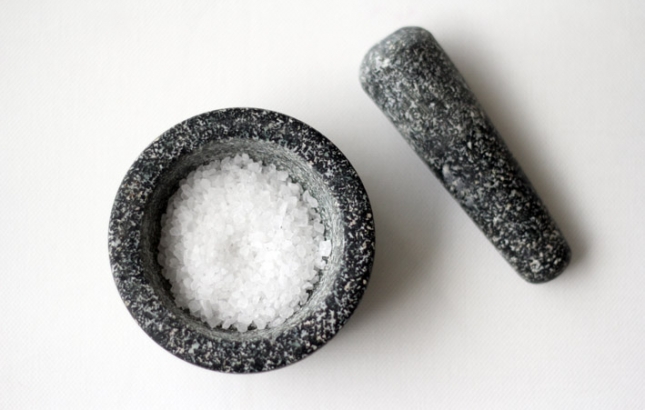
Salt of the Earth
Salt has had a shaky old time in the popularity stakes over the years. What was once a highly prized commodity to our ancestors has suffered a downfall in more recent times and it’s now often viewed as the evil culprit of many modern health ailments. It’s increased availability and affordability has meant that we now take its supply for granted, and with this comes a massive over-consumption. But how important is salt in our modern world and is it worthy of the demonising reputation that the health sector has sometimes placed on it? There’s a sea of facts to filter through, so let’s lay the great salt debate out on the table and get it straight…
Salt has had a shaky old time in the popularity stakes over the years. What was once a highly prized commodity to our ancestors has suffered a downfall in more recent times and it’s now often viewed as the evil culprit of many modern health ailments. It’s increased availability and affordability has meant that we now take its supply for granted, and with this comes a massive over-consumption. But how important is salt in our modern world and is it worthy of the demonising reputation that the health sector has sometimes placed on it? There’s a sea of facts to filter through, so let’s lay the great salt debate out on the table and get it straight…
Recent posts by Renée Leonard-Stainton
Whether it’s popular or unpopular, salt remains a vital constituent of human life. Almost 75% of our body is made up of water. However, this water is not in its pure form. It has salt dissolved in it which helps in a number of functions of the body. Salt present in the cells and tissues of our bodies helps in muscle contraction, proper conduction of nerve impulses and transportation of nutrients into the cells. The major constituent of salt is sodium, a vital component of all bodily fluids – quite literally ‘blood, sweat and tears’. Sodium, in combination with potassium, is necessary for maintaining proper water balance and blood pH. It is also needed for stomach, nerve, and muscle function.
Excessive sodium intake can result in:
- Edema (fluid retention)
- High blood pressure
- Heart disease
- Potassium deficiency
- Liver and kidney disease.
Sodium deficiency is rare – in fact most people have adequate (if not excessive) levels of sodium in their bodies, but it can occur. This condition is most likely to affect people who take diuretics for high blood pressure, especially if they simultaneously adhere to low-sodium diets. Symptoms of sodium deficiency can include:
- Abdominal cramps
- Loss of appetite
- Confusion
- Dehydration
- Depression
- Dizziness
- Fatigue
- Flatulence
- Hallucinations
- Headache
- Heart palpatations
- An impaired sense of tastes
- Low blood pressure
- Memory impairment
- Nausea and vomiting
- Poor coordination
- Seizures and weight loss
We actually only need 1-2g of sodium a day, although the official daily requirements are set to a more realistic 1-6 g per day. Despite this, we are still eating more than the recommended levels, with salt being the most common source of sodium in the diet. The World Health Organisation has estimated that a population-wide reduction in dietary intake of sodium by 2.9g per day would lead to a 22% reduction in the number of deaths from stroke and a 16% reduction in deaths from heart disease. Foods eaten without salt may seem less tasty at first, but with repetition, we can learn to enjoy the natural flavours of many unsalted foods. Strategies to cut salt intake include:
- Cook with little or no added salt
- Prepare foods with sodium-free flavours such as lemon juice, vinegar or wine, and sodium-free spices such as basil, bay leaves, curry, garlic, ginger, mint, oregano, pepper, rosemary, and thyme
- Add little or no salt at the table and taste foods before adding salt
- Read labels with an eye open for salt
- Select low-salt or salt-free products when available
Use these foods sparingly:
- Foods prepared in brine such as pickles, olives and sauerkraut
- Salty or smoked meats such as corned beef, bacon, frankfurters, ham and sausage
- Salty or smoked fish such as anchovies, caviar, salted and dried cod, herring, sardines and smoked salmon
- Snack items such as potato chips, pretzels, salted popcorn, salted nuts and crackers
- Condiments such as stock cubes, MSG, soy, teriyaki, Worcestershire sauce, prepared horseradish, catsup and mustard
- Processed cheeses
- Canned and instant soups.
In general, processed foods have the most sodium, while unprocessed foods such as fresh fruits, vegetables, milk, and meats have the least. In fact, as much as 75% of the sodium in our diets comes from salt added to food by manufacturers, about 15% comes from salt added while cooking and at the table, and only 10% comes from the natural content in foods.
It’s important to note that all types of salt contain sodium, the constituent associated with blood pressure. This includes grains, flakes and crystals, whether it’s from the sea or rock. When shopping for salt, you’ve got lots of options. You can buy sea salt or regular salt, finely textured or coarse. It might be white, grey, pink, but the four main types available to us are table salt, sea salt, kosher salt and iodized salt.
Iodized salt - This is salt which has been fortified with the addition of the mineral ‘iodine’. This is done because iodine deficiency and related diseases are common in some countries. You can buy both regular and sea salt with or without added iodine. Some people don’t like iodized salt because they feel iodine adds a noticeable flavor. Others just want to keep their salt closer to nature. If you prefer not to use iodized salt, you can also get iodine in seafood and edible seaweeds. Vegetables can be a source of iodine, depending on the iodine content of the soil in which it they’re grown. Even if you don’t use iodized salt at home, a lot of processed and prepared foods are made with iodized salt
Sea Salt - Sea water contains more than just sodium chloride. Other trace minerals may also be dissolved in it and fine particles of clay may be suspended in it. These impurities are filtered out of kosher and table salt. If you don’t filter them out, those sediments and minerals will affect the appearance and flavor of the finished salt. In fact, the “impurities” found in the sea water of some regions of the world are especially prized. Perhaps your palate is sensitive enough to detect the subtle fragrance of volcanic clay or French dust?! Sea salt is produced through evaporation of seawater, usually with little processing, which leaves behind some trace minerals and elements. It is 98% sodium chloride, while the remaining 2% is made of other important minerals like iron, sulfur, magnesium and other trace elements. Due to higher mineral content, sea salts are more flavored than table salt.
Table Salt - The common table salt is 99.9% sodium chloride. Table salt is mined from underground salt deposits. It is more heavily processed to eliminate trace minerals and usually contains an additive to prevent clumping. Most table salt also has added iodine. Often anti-caking agents are added to table salt to make it free flowing.
Kosher Salt - This inexpensive coarse salt is evaporated from brine, usually under specific conditions approved by the Orthodox Jewish faith. It contains no additives or added iodine. Kosher salt is popular among chefs because its coarse texture makes it easy to pinch up between your fingers and sprinkle onto foods.
Salt is more than just a flavor jump-start. It is one of the four basic flavors and an essential nutrient that our bodies rightfully crave. As with most nutrients though too much or too little can be harmful.
Live well, live long, live naturally
Renée x



